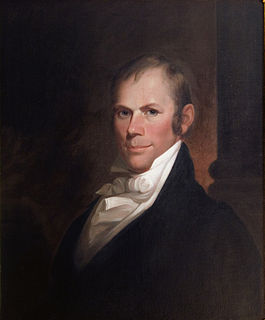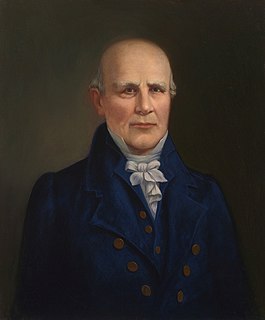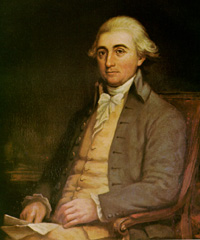
The 2nd United States Congress, consisting of the United States Senate and the United States House of Representatives, met at Congress Hall in Philadelphia, Pennsylvania, from March 4, 1791, to March 4, 1793, during the third and fourth years of George Washington's presidency. The apportionment of seats in the House of Representatives was based on the provisions of Article I, Section 2, Clause 3 of the United States Constitution. Additional House seats were assigned to the two new states of Vermont and Kentucky. Both chambers had a Pro-Administration majority.

Elections to the United States House of Representatives for the 17th Congress were held at various dates in different states between July 1820 and August 1821 as President James Monroe won reelection unopposed.

Elections to the United States House of Representatives for the 12th Congress were held at various dates in different states between April 1810 and August 1811 during President James Madison's first term.

Elections to the United States House of Representatives for the 8th Congress were held at various dates in each state, from April 26, 1802 to December 14, 1803 during Thomas Jefferson's first term in office. It was common in the early years of the United Congress for some states to elect representatives to a Congress after it had already convened. In the case of the 8th Congress, the representatives from New Jersey were only elected after its first meeting on October 17, 1803.

Elections to the United States House of Representatives for the 3rd Congress were held in 1792 and 1793, coinciding with the re-election of George Washington as President. While Washington ran for president as an independent, his followers formed the nation's first organized political party, the Federalist Party, whose members and sympathizers are identified as pro-Administration on this page. In response, followers of Thomas Jefferson and James Madison created the opposition Democratic-Republican Party, who are identified as anti-Administration on this page. The Federalists promoted urbanization, industrialization, mercantilism, centralized government, and a broad interpretation of the United States Constitution. In contrast, Democratic-Republicans supported the ideal of an agrarian republic made up of self-sufficient farmers and small, localized governments with limited power.

Elections to the United States House of Representatives for the 2nd Congress took place in 1790 and 1791, in the middle of President George Washington's first term. While formal political parties still did not exist, coalitions of pro-Washington (pro-Administration) representatives and anti-Administration representatives each gained two seats as a result of the addition of new states to the union.

Elections to the United States House of Representatives for the 1st Congress were held in 1788 and 1789, coinciding with the election of George Washington as first President of the United States. The dates and methods of election were set by the states. Actual political parties did not yet exist, but new members of Congress were informally categorized as either "pro-Administration" or "anti-Administration".

Maryland's 8th congressional district stretches from the northern Washington, D.C. suburbs north towards the Pennsylvania border. The district is currently represented by Democrat Jamie Raskin.

Maryland's 1st congressional district encompasses the entire Eastern Shore of Maryland, including Salisbury, as well as parts of Baltimore, Harford and Carroll counties.

Maryland's 6th congressional district elects a representative to the United States House of Representatives from the northwest part of the state. Today the district comprises all of Garrett, Allegany, and Washington counties as well as portions of Montgomery and Frederick counties. The seat is currently represented by David Trone (D), who lives outside the district.

Maryland's 7th congressional district of the United States House of Representatives encompasses just over half of the city of Baltimore, some sections of Baltimore County, and the majority of Howard County. The district was created following the census of 1790, which gave Maryland one additional representative in the House. It has been drawn as a majority-African American district since 1973. Kweisi Mfume is the current representative, winning a special election on April 28, 2020 to finish the term of Elijah Cummings, who died in October 2019.

Maryland's 3rd congressional district comprises portions of Baltimore, Howard, Montgomery and Anne Arundel counties, as well as a significant part of the independent city of Baltimore. The seat is currently represented by John Sarbanes, a Democrat. Landmarks in the district include Fort McHenry and the state capital, Annapolis.

Maryland's 4th congressional district comprises portions of Prince George's County and Anne Arundel County. The seat is represented by Anthony G. Brown, a Democrat.

Maryland's 5th congressional district comprises all of Charles, St. Mary's, and Calvert counties, as well as portions of Prince George's and Anne Arundel counties. The district is currently represented by Democrat Steny Hoyer, the current House Majority Leader.

Alexander Xavier Mooney is the U.S. Representative for West Virginia's 2nd congressional district since 2015. He is a member of the Republican Party. He served in the Maryland State Senate, representing District 3, from 1999 to 2011 and is a former Chairman of the Maryland Republican Party. He is the first Hispanic elected to Congress from West Virginia.

The 1789 United States House of Representatives elections in Maryland were held from December 15, 1788, to January 10, 1789, to elect the six U.S. Representatives from the state of Maryland, one from each of the state's six congressional districts. The elections coincided with the 1788–89 U.S. presidential election , as well as other elections to the House of Representatives, elections to the United States Senate and various state and local elections.

The 1816 special elections for Maryland's 5th congressional district were to fill two separate vacancies. The 5th district was a plural district, with two seats. Both seats were vacated, the first by Representative Nicholas R. Moore (DR) in 1815, before the 14th Congress even met, and the second by Rep. William Pinkney (DR) on April 18, 1816 after being named Minister to Russia.

A special election was held in Maryland's 3rd congressional district in 1816 to fill a vacancy left by the resignation of Alexander C. Hanson (F) upon being elected to the United States Senate.

The 2014 United States House of Representatives elections in Maryland were held on Tuesday, November 4, 2014 to elect the eight U.S. Representatives from the state of Maryland, one from each of the state's eight congressional districts. The elections coincided with other elections to the United States Senate and House of Representatives and various state and local elections, including the Governor of Maryland, Attorney General of Maryland and Comptroller of Maryland.

The 2020 United States House of Representatives elections in Maryland was held on November 3, 2020, to elect the eight U.S. Representatives from the state of Maryland, one from each of the state's eight congressional districts. The elections coincided with the 2020 U.S. presidential election, as well as other elections to the House of Representatives, elections to the United States Senate and various state and local elections. On March 17, 2020, Governor Larry Hogan announced that the primary election would be postponed from April 28 to June 2 due to coronavirus concerns. On March 26, the Maryland Board of Elections met to consider whether in-person voting should be used for June's primary, and recommended that voting in June be mail-in only.

















